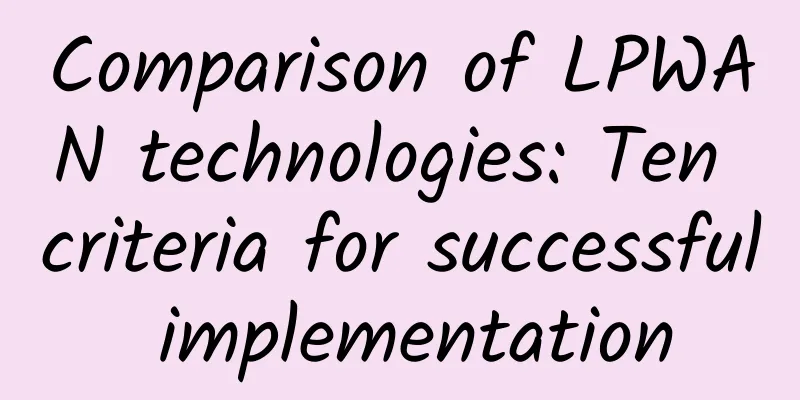Comparison of LPWAN technologies: Ten criteria for successful implementation

|
Low Power Wide Area Network (LPWAN) is the fastest growing IoT communication technology and the main driver of IoT connections worldwide. With the emergence of various LPWAN solutions and vendors, choosing the right technology for your IoT project is not an easy task. To help you choose the right solution, we are working on a two-part series of help articles. In this first article, we will discuss the top ten criteria for selecting the best LPWAN technology based on your use case and requirements.
1. Reliability The importance of industrial-grade reliability cannot be overstated, especially in mission-critical applications. High receive rates and minimal packet loss eliminate the need to resend messages, even under adverse conditions. This ensures that important data arrives quickly while increasing energy efficiency. For LPWAN technologies operating in increasingly crowded, unlicensed spectrum, interference immunity is a prerequisite for ensuring high reliability. LPWAN technology design determines the ability to avoid interference or packet collisions during periods of high traffic, thereby improving overall reception rates. 2. Security Message confidentiality, authentication, and integrity are core elements of network security. Multi-layered end-to-end encryption should be embedded in the network to protect message confidentiality and prevent eavesdropping and potential compromise. Advanced Encryption Standard (AES) is a lightweight, powerful encryption algorithm used for data encryption in IoT networks. Typically, 128-bit AES is used to establish network-level security for data communications over the air interface (from the end node to the base station). At the same time, the Transport Layer Security (TLS) protocol for backhaul connections provides a supplementary security layer to protect IP-based data transmission to the cloud. The most secure LPWAN technologies also include strict message authentication mechanisms to confirm the authenticity and integrity of messages. This ensures that only valid devices can communicate over your network and that messages cannot be tampered with or altered during transmission. 3. Network capacity The huge network capacity enables you to expand according to the growing demand of data collection points without affecting the quality of service. In addition, since the wireless coverage of low-power wide-area network technology is almost the same, network capacity becomes an important indicator of infrastructure coverage. The more terminal devices and daily messages a single base station supports, the less infrastructure you need. Efficient use of limited radio spectrum, or spectral efficiency, is important for achieving large network capacity. In this case, ultra-narrowband methods with minimal bandwidth usage provide very high spectral efficiency, allowing more messages to fit into the allocated frequency band without overlapping each other. (Source: IoT Home Network) At the same time, low-power wide-area network systems that use asynchronous communication require a mitigation scheme to prevent packet collisions (i.e., self-interference) as the number of messages and transmission frequency increase. 4. Battery Life Battery life has a significant impact on your total cost of ownership and your company’s sustainability goals. While LPWAN technologies share a common approach to reducing power consumption, battery life varies widely from system to system. This is due to significant differences in radio time on the air (or actual transmission time of a message), which is especially important given that transmission is the most power-intensive activity. In cellular-based LPWANs, synchronous communications with high overhead and handshaking requirements can also quickly drain the battery. 5. Mobile Support Devices moving along the propagation path, mobile base stations, or moving obstacles are all sources of Doppler shifts and deep fading that cause packet errors. Low-power wide-area network technologies that lack the ability to resist the Doppler effect can only support data communications from stationary or slowly moving terminal devices. This limits their applicability in specific IoT use cases such as IoT fleet management. Similarly, these networks may not be able to connect nodes operating in rapidly changing environments, such as equipment installed next to a highway and when vehicles travel at speeds exceeding 100 km/h. 6. Public and private networks When choosing a LPWAN solution, you also need to consider which is better suited to your needs - a public network or a private network. The biggest advantage of a public LPWAN operated by a network operator is saving infrastructure costs. However, a public LPWAN means that you will be dependent on the provider's network coverage, which is often far from global coverage. Public LPWANs leave coverage blind spots in many areas, and nodes operating at the edge of the network often suffer from unreliable connections. (Source: IoT Home) On the other hand, private networks allow end users to quickly deploy with flexibility in network design and coverage based on their own needs. Another major disadvantage of public networks is data privacy issues on centralized backends and cloud servers. 7. Proprietary and Standard Industry-standard LPWAN technology that supports multiple hardware vendors and adopts a software-defined approach helps avoid vendor lock-in issues while promoting long-term interoperability. As a result, adopters have the flexibility to adapt to future technology trends and changing corporate needs. Solutions standardized and recognized by standards development organizations through a rigorous evaluation process also provide guaranteed credibility and service quality. 8. Operating frequency Operating frequency is another factor to consider when selecting LPWA technology, as it can significantly impact network performance. Due to the high cost barriers of licensed frequency bands, most LPWA vendors utilize unlicensed industrial, scientific, and medical (ISM) bands to accelerate technology development and deployment. Although there are many ISM bands available today, there are some key differences between the 2.4 GHz band and the sub-GHz bands. Generally, low-power wide area networks operating at 2.4 GHz offer higher data throughput, but at the expense of shorter range and battery life. On top of that, 2.4 GHz radio waves have poorer penetration into buildings and are subject to higher co-channel interference. 9. Data rate Each IoT application has different data rate requirements and should be weighed against the LPWAN solution being considered. It is worth noting that most IoT remote monitoring applications have fairly high latency tolerance and only require periodic data transmission. Since faster data rates often come with trade-offs in range and power consumption, choosing a solution that best balances these criteria will benefit return on investment. 10. Variable payload size Payload or user data size should be driven by actual IoT application needs rather than fixed by a certain technology. LPWAN solutions with variable payload sizes allow users to seamlessly integrate new use cases into their existing network infrastructure regardless of payload requirements. Ultimately, it’s the technology and technical design behind a LPWAN solution that determines how it performs across the above criteria. In the second article in this series, we’ll take a deeper look at the four main LPWAN technology groups and how they deliver on these parameters. Stay tuned! |
<<: Is 5G really invincible? The sixth generation of Wi-Fi disagrees
>>: Example: How to plan IP addresses for a large-scale monitoring network system?
Recommend
China Mobile may withdraw all 3G networks by 2020, but terminals still need to support GSM
At the Global Terminal Summit held recently, Chin...
Why do many people still insist on buying 4G mobile phones even though 5G networks have been fully commercialized?
Although 5G networks have been fully commercializ...
Huawei Cloud Inclusive AI Open Day "Planting Grass" Record: Get Close to 2012 Lab + MVP, Two "Group Favorites"
[51CTO.com original article] Let me start with a ...
Why is network proxy technology so popular? Forward proxy | Reverse proxy
1. The concept of agency I believe everyone has h...
Is the future of the new WIFI standard 802.11ad reliable?
Now there is a new WIFI standard that can increas...
Satellite Internet: The war is already raging
[[323965]] On April 20, satellite Internet was cl...
Operators are once again caught in the whirlpool of public opinion about "stealing traffic"; optimizing billing methods may alleviate user doubts
Operators are once again at the center of controv...
VMware SD-WAN by VeloCloud Optimizes Edge Device Connectivity
VMware SD-WAN by VeloCloud prioritizes centralize...
Manually implement UDP and TCP communication
[[336022]] UDP UDP is a connectionless protocol, ...
Changchun Municipal Government Signs Strategic Cooperation Agreement with Huawei Cloud Computing Data Center
On the afternoon of March 31, the Changchun Munic...
SAP HANA Express Edition for Developers Launched on Huawei Cloud
On September 5, during HUAWEI CONNECT 2017, Huawe...
The road to communication - what do bridges, gateways, switches, and routers mean?
In network communications, there are several very...
Talk about the past and present of programmable network elements
[[402793]] This article is reprinted from the WeC...
F5 Launches Unity+ Channel Partner Program to Help Drive Business Growth and Win-Win
Recently, F5 Networks, a global application deliv...
Dedicated 5G networks for smart sports stadiums and venues
Advances in technology are dramatically changing ...









